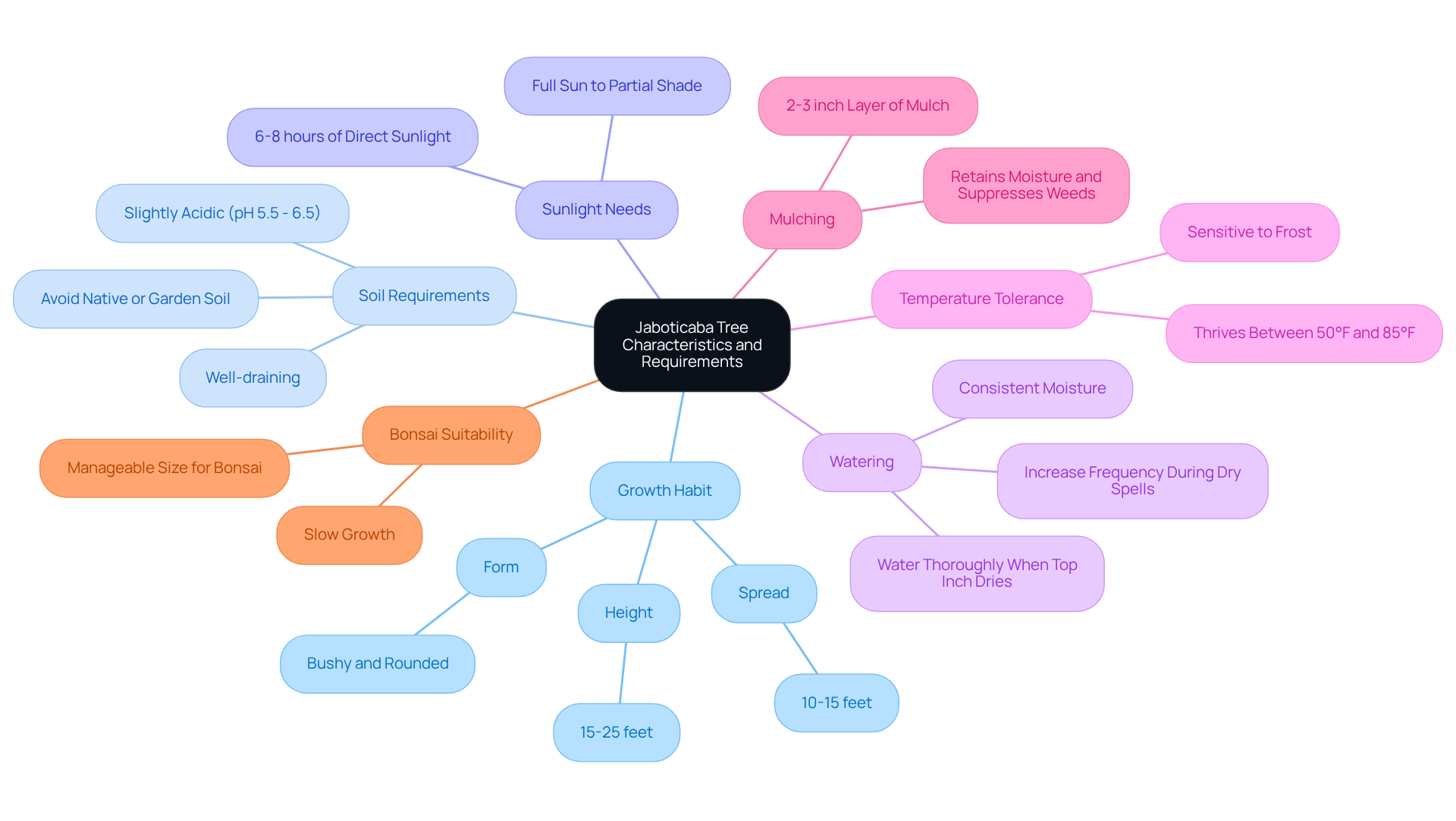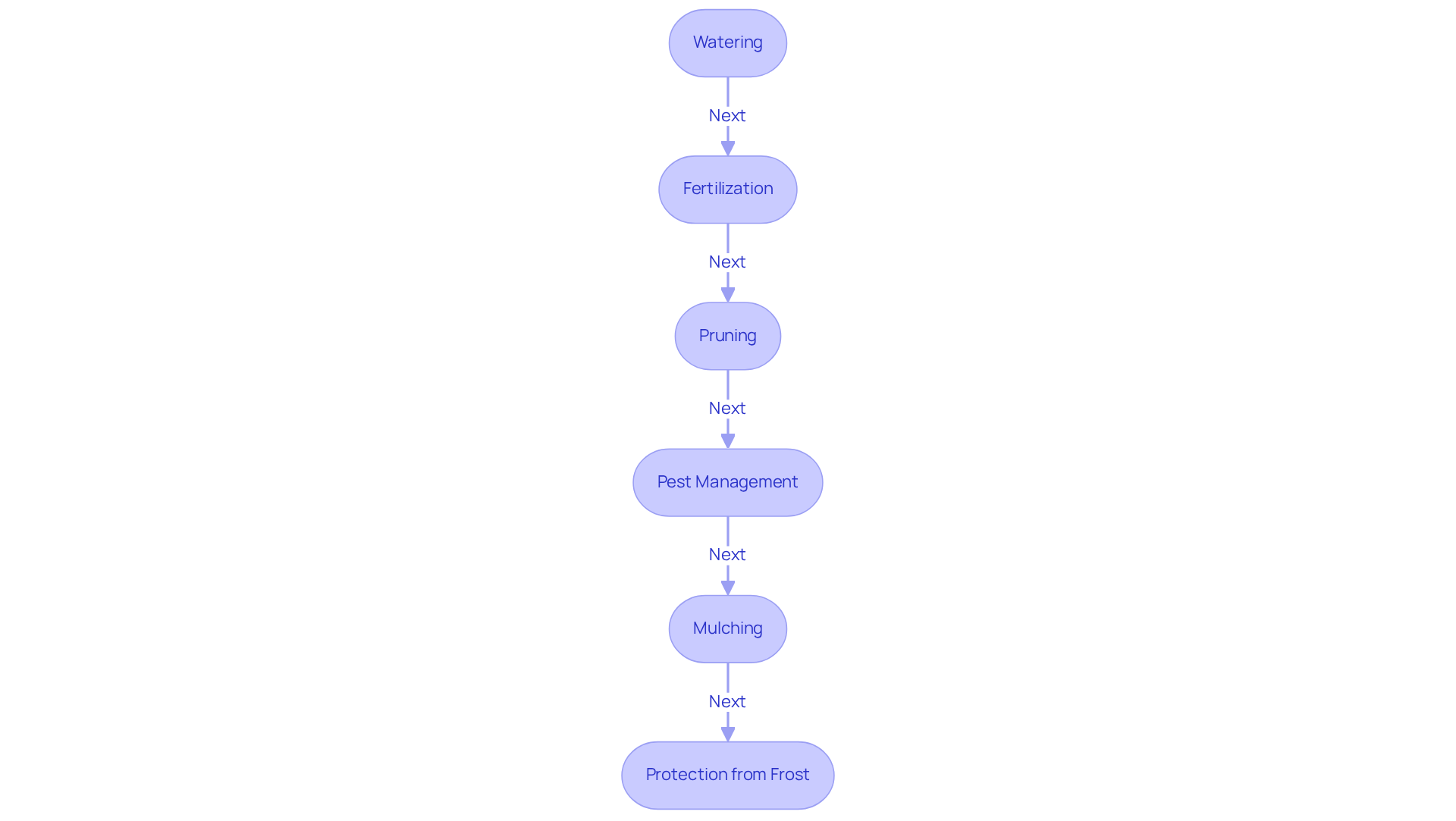
Jaboticaba Tree: Step-by-Step Planting and Care Guide
Share
The jaboticaba tree, a striking tropical gem native to Brazil, captivates gardeners with its remarkable ability to bear fruit directly on its trunk. This unique feature, along with its manageable size and appealing appearance, positions it as an attractive addition to any garden.
However, successfully cultivating this extraordinary species necessitates a comprehensive understanding of its specific requirements, including soil conditions and watering practices.
Want to grow a Jaboticaba Tree in your garden?
Explore Jaboticaba Trees Collection at Everglades Farm - shipped directly from Florida.
What challenges may arise in nurturing this exotic tree, and how can one ensure a plentiful harvest of its delicious fruits?
1. Understand the Jaboticaba Tree: Characteristics and Requirements
The jaboticaba tree, also known as Plinia cauliflora, is a remarkable tropical fruit species native to Brazil, celebrated for its unique ability to produce purplish-black fruits directly on its trunk and limbs. Understanding its essential characteristics and cultivation requirements can significantly enhance your gardening success.
The growth habit of the jaboticaba tree typically sees it attain heights of 15 to 25 feet and spread 10 to 15 feet at maturity, exhibiting a bushy, rounded form complemented by glossy leaves. Through careful pruning, they can be maintained at a smaller size, making them suitable for a variety of garden spaces.
- Soil Requirements: These plants thrive in well-draining, slightly acidic soil, preferring a pH range of 5.5 to 6.5. It is advisable to avoid using native or garden soil, as these may lack the necessary drainage and acidity for optimal growth.
For optimal growth and fruiting, the jaboticaba tree requires at least 6 to 8 hours of direct sunlight each day. They flourish in conditions ranging from full sun to partial shade, providing versatility for different garden settings.
Consistent moisture is crucial for the watering needs of the jaboticaba tree. Water thoroughly when the top inch of soil dries out, ensuring the ground remains damp but not saturated. During dry spells, it is essential to increase the frequency of watering to maintain adequate soil moisture.
- Temperature Tolerance: Sensitive to frost, these plants thrive in temperatures between 50°F and 85°F. It is important to protect young plants from cold drafts and severe temperature fluctuations to promote healthy growth.
- Mulching: A 2-3 inch layer of mulch around the base of the fruit-bearing plant is beneficial for retaining moisture, suppressing weeds, and regulating soil temperature.
Fruiting behavior of the jaboticaba tree shows that it may take 6-8 years to yield its first fruits, yet it can produce abundantly, sometimes twice a year, rewarding the gardener's patience with plentiful harvests.
- Bonsai Suitability: Due to their slow growth and manageable size, the jaboticaba tree is often cultivated as a bonsai specimen, appealing to gardening enthusiasts interested in this art form.
By understanding these traits, you can create an optimal environment for your jaboticaba tree, which will enhance its potential to thrive and yield a bountiful harvest.

2. Plant the Jaboticaba Tree: Step-by-Step Instructions
To successfully plant your jaboticaba tree, follow these detailed steps.
-
Choose the right location.
Opt for a site that receives full sun to partial shade, ensuring good air circulation and protection from strong winds. -
Prepare the soil.
Create a well-draining mix by combining equal parts of peat moss, perlite, and compost; this blend provides the necessary acidity and drainage for optimal growth. -
Dig the hole.
Excavate a hole that is twice as wide and as deep as the root ball of your jaboticaba tree, allowing ample space for root expansion.
Carefully remove the plant from its container, avoiding root damage. If the roots are tightly bound, gently loosen them to promote healthy growth. -
Position the tree.
Place the tree in the center of the hole, ensuring the top of the root ball is level with the surrounding ground.
Avoid planting too deep to prevent root rot. -
Backfill the hole.
Fill the hole with the prepared earth mixture, gently tamping it down to eliminate air pockets.
Water thoroughly to help settle the soil. -
Mulch around the base.
Apply a layer of organic mulch, keeping it a few inches away from the trunk to retain moisture and suppress weeds.
Water the newly planted sapling deeply to encourage root establishment. -
Check ground moisture regularly.
Ensure it stays consistently damp.
By following these steps, you will create a strong base for your plant, encouraging healthy growth and yield.

3. Care for Your Jaboticaba Tree: Maintenance and Support
To ensure your Jaboticaba tree thrives and produces fruit, adhere to the following care guidelines:
- Watering: Keep the soil consistently moist, particularly during dry spells. Water deeply, allowing the top 1-2 inches of soil to dry out between waterings to prevent waterlogging, which can harm the roots. Ensure abundant water, especially when the top layer is dry.
- Fertilization: Apply a balanced fertilizer specifically designed for bearing plants with an N-P-K ratio of 10-10-10 every 2-3 months during the growing season. Focus on fertilizers with a high phosphorus content to support flowering and fruiting, adjusting the regimen to be lighter in winter.
- Pruning: Perform optimal pruning in early to late spring to shape your plant and remove any dead or diseased branches. This practice enhances air circulation and light penetration, promoting healthier growth and increased fruit yield.
- Pest Management: Regularly examine your plant for common pests such as aphids, scale insects, and passion vine hoppers. If infestations occur, treat them promptly with organic insecticidal soap or neem oil to minimize damage. Identifying and managing these pests early is crucial for maintaining the health of your jaboticaba tree. Additionally, consider implementing preventive measures such as introducing beneficial insects that can help control pest populations.
- Mulching: Renew the mulch layer annually to assist in retaining moisture and inhibit weed development. Organic mulch will also enrich the soil as it breaks down, providing additional nutrients.
- Protection from Frost: In cooler climates, shield your plant from frost by covering it with frost cloth or moving it indoors during cold snaps. Mature specimens can withstand temperature declines to approximately 30°F for a few hours, but safeguarding is essential for preserving the plant's health during the winter season.
By applying these care practices, you will promote the healthy development of your plant and improve its capacity for fruit production.

4. Troubleshoot Common Issues: Solutions for Jaboticaba Tree Care
Here are some common issues you may encounter with your Jaboticaba tree, along with effective solutions to resolve them:
- Leaf Drop: If your tree is dropping leaves, it may be due to underwatering or sudden temperature changes. To maintain a stable environment, ensure consistent watering and shield the plant from drafts.
- Brown Leaf Tips: This condition often indicates underwatering, excessive fertilizer, or high salt content in the soil. Adjust your watering schedule and consider using a balanced fertilizer to promote healthy growth.
- Poor Fruit Production: If your plant is not yielding fruit, it may be too young or not receiving sufficient sunlight. Ensure it receives a minimum of 4-6 hours of direct sunlight each day. Be patient, as this species usually takes five to nine years to attain fruit-bearing maturity.
- Pest Infestations: Common pests such as aphids and scale insects can affect your jaboticaba tree. Regularly inspect your tree and treat infestations promptly with organic insecticidal soap or neem oil to minimize damage. Implementing Integrated Pest Management (IPM) can also help manage pests sustainably by combining cultural, biological, and mechanical controls.
- Root Rot: Signs of wilting despite adequate watering may indicate root rot due to poor drainage. Ensure the soil is well-draining and consider repotting if necessary to improve root health.
By proactively addressing these common issues and conducting routine inspections, you can enhance the health and productivity of your jaboticaba tree, which ensures a fruitful gardening experience.
Conclusion
The jaboticaba tree, renowned for its unique fruiting habits and tropical allure, provides a fulfilling gardening experience for those who dedicate time and care. By comprehending the specific characteristics and requirements of this exceptional species, gardeners can cultivate an environment that fosters healthy growth and prolific fruit production.
Key considerations for successfully growing the jaboticaba tree include:
- Selecting an optimal location with sufficient sunlight
- Preparing appropriate soil
- Maintaining consistent moisture levels
- Establishing a regular care routine
Furthermore, addressing common challenges such as leaf drop, brown tips, and pest infestations with proactive measures guarantees the longevity and productivity of the tree.
Embracing the process of cultivating a jaboticaba tree not only enhances one's gardening skills but also beautifies the landscape with its striking appearance and delightful fruits. By adhering to the recommended steps and care practices, anyone can experience the gratification of nurturing this extraordinary plant, ultimately leading to a bountiful harvest that celebrates the splendor of nature.
Grow Your Own Jaboticaba Tree Today!
Discover the joy of tropical gardening with Everglades Farm - quality trees delivered to your doorstep.
Frequently Asked Questions
What is the jaboticaba tree and where is it native to?
The jaboticaba tree, also known as Plinia cauliflora, is a tropical fruit species native to Brazil, known for producing purplish-black fruits directly on its trunk and limbs.
What are the typical growth characteristics of the jaboticaba tree?
The jaboticaba tree typically grows to heights of 15 to 25 feet and spreads 10 to 15 feet at maturity, exhibiting a bushy, rounded form with glossy leaves.
What soil conditions are best for growing jaboticaba trees?
Jaboticaba trees thrive in well-draining, slightly acidic soil with a pH range of 5.5 to 6.5. It is advisable to avoid using native or garden soil that may lack the necessary drainage and acidity.
How much sunlight do jaboticaba trees need?
Jaboticaba trees require at least 6 to 8 hours of direct sunlight each day and can flourish in conditions ranging from full sun to partial shade.
What are the watering requirements for jaboticaba trees?
Consistent moisture is crucial; water thoroughly when the top inch of soil dries out, ensuring the ground remains damp but not saturated. Increase watering frequency during dry spells.
What temperature range is ideal for jaboticaba trees?
Jaboticaba trees thrive in temperatures between 50°F and 85°F and are sensitive to frost. Young plants should be protected from cold drafts and severe temperature fluctuations.
How does mulching benefit jaboticaba trees?
A 2-3 inch layer of mulch around the base of the jaboticaba tree helps retain moisture, suppress weeds, and regulate soil temperature.
How long does it take for jaboticaba trees to produce fruit?
Jaboticaba trees may take 6-8 years to yield their first fruits, but they can produce abundantly, sometimes twice a year.
Can jaboticaba trees be grown as bonsai?
Yes, due to their slow growth and manageable size, jaboticaba trees are often cultivated as bonsai specimens, appealing to gardening enthusiasts.


